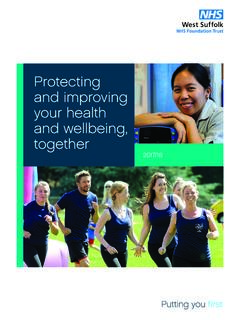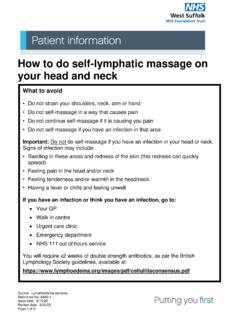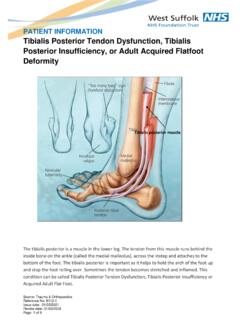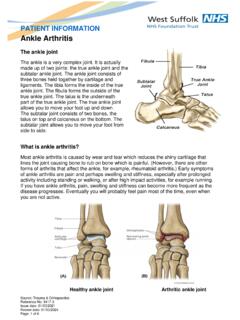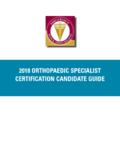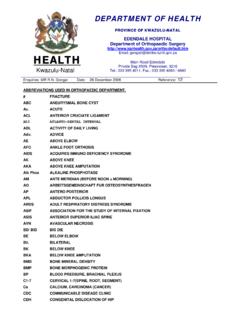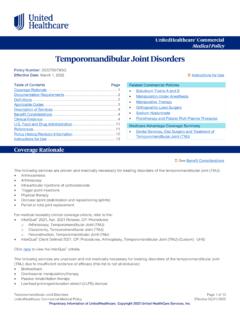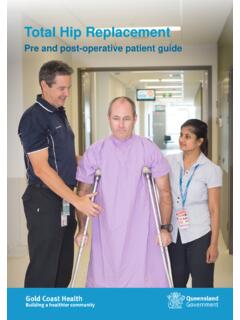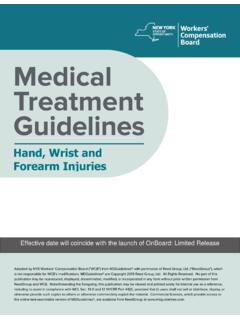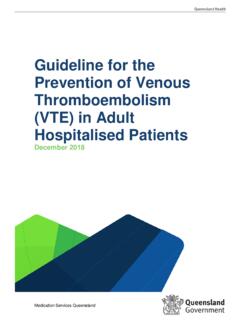Transcription of PATIENT INFORMATION Shoulder Replacement Surgery
1 Source: Orthopaedics/Physiotherapy Reference No: 5055-7 Issue date: 01/03/2021 Review date: 01/03/2024 Page 1 of 12 PATIENT INFORMATION Shoulder Replacement Surgery Introduction This booklet is designed to give you a general understanding of what happens before and after your operation. It may help to prepare you for the operation and also show how you can assist in your recovery. If you are given this booklet before your operation, please bring it with you when you come for any clinic appointments, Pre-Admission Clinic and your admission. Then keep this booklet in a safe place, as you may need to refer to it from time to time.
2 If there is anything that you do not understand, please ask a member of the orthopaedic staff. Your Shoulder The Shoulder joint itself consists of a ball and a socket. The ball is on the bone of the upper arm (the humerus) and the socket on the Shoulder blade (the scapula). The joint is supported by the rotator cuff muscles. These muscles may become damaged after trauma or with age. Shoulder Replacements You will be admitted for Surgery to your Shoulder because of arthritis of the Shoulder joint. Arthritis occurs as a result of either an inflammatory condition (for example rheumatoid arthritis) or as a result of osteoarthritis.
3 Osteoarthritis may occur after a fracture, previous dislocation or muscle weakness. As a result the joint becomes painful and stiff. Page 2 of 12 Surgery Surgery is performed either under general anaesthetic or under sedation along with a nerve block of the area. Your anaesthetist will advise you about the most appropriate anaesthetic. At Surgery the Shoulder joint is replaced with an artificial joint. There are two main types of Shoulder Replacement : 1. Shoulder Replacement : At Surgery the ball at the top of the humerus is removed and replaced with an artificial component. The socket is prepared to accept a plastic cup which is inserted using bone cement.
4 2. Inverse/Reverse polarity Shoulder Replacement . If you have lost the rotator cuff muscles this implant may be used. At Surgery the ball at the top of the humerus is replaced with a socket. The socket on the Shoulder blade is replaced with a ball component. By reversing the usual ball and socket anatomy an improvement in muscle function is often seen. This operation is only really done in patients above the age of 70 years. There are other types of Shoulder Replacement Surgery in which a different component may be used (for example if you have fractured your Shoulder ) or the cup is not replaced (for example if the cup is not worn or is worn to an extent that it cannot support a new cup).
5 Your surgeon may plan to do one type of operation however the particular technique and choice of implants may be decided during the operation, depending on the operative findings. If Surgery has been performed using a nerve block the operated area is usually numb for 12-18 hours after Surgery . At that time pain will increase and it is important that you then start taking your painkillers again. The Surgery is performed through an incision over the front of the Shoulder taking down one of the Shoulder muscles. At the end of the operation this muscle is re-inserted but it will have to be protected for at least 6 weeks post-operatively until it has fully healed.
6 Following Surgery the arm rests in a collar and cuff. You should continue using this sling for 2-4 weeks or until good Shoulder muscle control has been obtained. Pre-Admission Process Shoulder Surgery INFORMATION Group The first step towards your admission is the Shoulder Surgery INFORMATION Group. The aim is to provide important INFORMATION to prepare for Surgery . You will meet patients who are also awaiting similar Surgery or in some cases will have already had Surgery to their Shoulder . Page 3 of 12 Pre-Admission Clinic You will be called to a Pre-Admission Clinic in the month prior to your admission.
7 At this clinic, you are seen by a nurse, members of the rehabilitation team and on occasion an anaesthetist in order to make sure you are fit for the operation. The staff in the clinic will carry out a number of tests including blood pressure measurement, taking swabs to check for MRSA and testing urine samples. You will also be examined, have blood tests and a heart tracing (ECG), and may have x-rays of your Shoulder . It is also an opportunity for us to plan for your safe and timely discharge. The Pre-Admission Unit is located opposite the Chapel within the hospital. This appointment allows us to pick up any potential problems and deal with Occasionally problems are detected that we do not have time to resolve and so your operation may need to be postponed.
8 To avoid the disappointment there are some things you can do to help prepare yourself. Be aware of your health If you suffer from any dizzy spells, breathing problems, chest pain or any new or unusual symptoms it is important to get these checked out by your GP. You may need to undergo further investigations or start taking some medication. It is also important that you inform the hospital if you are awaiting any investigations for heart or breathing problems or if you are waiting another operation. Page 4 of 12 Diet It is important that you have a healthy diet leading up to and after your Shoulder Surgery , as this will help with the healing process.
9 Smoking The West Suffolk Hospital is a smoke-free site. Smoke-free means that smoking is not permitted anywhere on site and applies to all staff, patients and visitors. Nicotine Replacement Therapy (NRT) should be taken into hospital by inpatients who smoke. You are not allowed to smoke during your stay. Although we recognise that it is difficult to give up smoking, it is advisable to do so before your operation. Smoking increases your risk of developing a chest infection following anaesthetic and also delays the healing of the bone and soft tissues. If you feel unable to give up on your own, your GP can offer you support.
10 High Blood Pressure If you take medication for high blood pressure then we would advise you to visit your GP or practice nurse regularly until your operation date to get your blood pressure checked. If your blood pressure is checked, please ensure your GP Surgery writes the readings down please bring these with you to the Pre-Admission Clinic. If you have your own blood pressure measurement device then it may be useful if you checked your blood pressure regularly to ensure that it is within the normal range. Ward admission All beds are allocated to patients waiting for Surgery . The ward will only ring you if there is a problem so please arrive on the ward by the time given on your admission letter.




